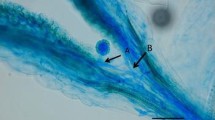Abstract
The self-incompatibility of tea plant (Camellia sinensis (L.) O. Kuntze) was studied with the methods of aniline blue fluorescence assay and paraffin sections. The characteristics of pollen tube elongation after hand pollination was analyzed in 4 tea cultivars, including ‘Keemenzhong’, ‘Longjing-changye’, ‘Fuding-dabaicha’ and ‘Yabukita’, under self-pollination and cross-pollination, respectively. Although there were some difference among cultivars, pollen tubes elongated through the style and reach the ovary successfully at 48 h after pollination for both cross- and self-pollen tubes in all the four cultivars of tea. Pollen tubes entered into the ovule micropyles, however, only for cross-pollination, but not for self-pollination. Pollen tubes of selfing plants, failed in fertilizing, seemed have some difficulties to enter the ovule. All of which indicated that the self-incompatibility of tea plant is a late-acting self-incompatibility system (LSI) or an ovarian sterility (OS), in which the self incompatibility was due to none self pollen tube penetrating into the ovule and no fertilization.
Similar content being viewed by others
References
Balasaravanan T., Pius P.K., Raj Kumar R., Muraleedharan N. & Shasany A.K. 2003. Genetic diversity among south Indian tea germplasm (Camellia sinensis, C. assamica and C. assamica spp. lasiocalyx) using AFLP markers. Plant Sci. 165: 365–372.
Bittencourt N.S. & Semir J. 2006. Floral biology and late-acting self-incompatibility in Jacaranda racemosa (Bignoniaceae). Aust. J. Bot. 54: 315–324.
Chen L., Zhao L.P. & Gao Q.K. 2005. Generation and analysis of expressed sequence tags from the tender shoots cDNA library of tea plant (Camellia sinensis). Plant Sci. 168: 359–363.
Chen L., Zhou Z.X. & Yang Y.J. 2007. Genetic improvement and breeding of tea plant (Camellia sinensis) in China: from individual selection to hybridization and molecular breeding. Euphytica 154: 239–248.
de Nettancourt D. 1997. Incompatibility in angiosperms. Sex Plant Reprod. 10: 185–199.
Fuchinoue Y. 1969. Studies on the analysis of self-incompatibility alleles of tea varieties and pseudogamy in the genus Camellia. Saitama-ken-Chagyo-Kenkyu-Hokoku 4: 1–92. (In Japanese with English summary)
Fuchinoue Y. 1979. Analysis of self-incompatibility alleles of major varieties of tea. Jpn. Agr. Res. Q. 13(1): 43–48.
Gibbs P.E. & Bianchi M.B. 1999. Does late acting self incompatibility (LSI) show family clustering? Two more species of Bignoniacea with LSI: Dolichandra cynanchoides and Tabebuia nodosa. Ann. Bot. 84: 449–457.
Hiratsuka S., Takahashi E. & Hirata N. 1987. Pollen tube growth inhibitors involved in the ovary of self-incompatible Japanese pear. Plant Cell Physiol. 28(2): 293–299.
Hiscock S.J. 2000. Genetic control of self-incompatibility in Senecio squalidus L. (Asteraceae). Heredity 85: 10–19.
Jiang C.J. 2005. Tea breeding. China Agricultural Press, Peiking, 255pp.
Kaundun S.S. & Matsumoto S. 2002. Heterologous nuclear and chloroplast microsatellite amplification and variation in tea, Camellia sinensis. Genome 45: 1041–1048.
Kunz C., Chang A., Faure J.D., Clarke A.E., Polya G.M. & Anderson M.A. 1996. Phosphorylation of style S-RNases by Ca2+ -dependent protein kinases from pollen tubes. Sex Plant Reprod. 9: 25–34.
McClure B. & Franklin-Tong V. 2006. Gametophytic self incompatibility: understanding the cellular mechanisms involved in ’self’ pollen tube inhibition. Planta 224: 233–245.
Mondal T.K. 2002. Assessment of genetic diversity of tea (Camellia sinensis (L.) O. Kuntze) by inter-simple sequence repeat polymerase chain reaction. Euphytica 128: 307–315.
Mondal T.K., Bhattacharya A., Laxmikumaran M. & Ahuja P.S. 2004. Recent advances of tea (Camellia sinensis) biotechnology. Plant Cell Tiss. Org. 76: 195–254.
Porcher E. & Lande R. 2005. Loss of gametophytic selfincompatibility with evolution of inbreeding depression. Evolution 59: 46–60.
Rogers S. 1975. Preliminary observations on pollen tube incompatibility in some tea clones. Tea Quarterly 45: 91–100.
Sage T.L., Price M.V. & Waser N.M. 2006. Self-sterility in Ipomopsis aggregata (Polemoniaceae) is due to prezygotic ovule degeneration. Am. J. Bot. 93(2): 254–262.
Sage T.L., Strumas F., Cole B. & Barrett S.C.H. 1999. Differential ovule development following self- and cross-pollination: the basis of self-sterility in Narcissus triandrus (Amaryllidaceae). Am. J. Bot. 86: 855–870.
Seavey S.R. & Bawa K.S. 1986. Late-acting self-incompatibility in angiosperms. Bot. Rev. 52: 195–219.
Shimura T. & Oosone K. 1956. Studies on the fertilization of tea plant. Japan. J. Breed. 6(2): 111–114.
Sijacic P., Wang X., Skirpan A.L., Wang Y., Dowd P.E., McCubbin A.G., Huang S.S. & Kao T.H. 2004. Identification of the pollen determinant of S-RNase-mediated self-incompatibility. Nature 429: 302–305.
Tanaka T. 1988. Cytogenetic studies on the origin of Camellia X vernalis. III. A method to identify the cultivars using self-incompatibility. J. Japan. Soc. Hort. Sci. 56(4): 452–456.
Wachira F.N. & Kamunya S.K. 2005. Pseudo-self-incompatibility in some tea clones (Camellia sinensis (L.) O. Kuntze). J. Hortic. Sci. Biotech. 80(6): 716–720.
Zhao L.P., Liu Z., Chen L., Yao M.Z. & Wang X.C. 2008. Generation and characterization of 24 novel EST derived microsatellite from tea plant (Camellia sinensis) and cross-species amplification in its closely related species and varieties. Conserv. Genet. 9: 1327–1331.
Author information
Authors and Affiliations
Corresponding author
Rights and permissions
About this article
Cite this article
Chen, X., Hao, S., Wang, L. et al. Late-acting self-incompatibility in tea plant (Camellia sinensis). Biologia 67, 347–351 (2012). https://doi.org/10.2478/s11756-012-0018-9
Received:
Accepted:
Published:
Issue Date:
DOI: https://doi.org/10.2478/s11756-012-0018-9




